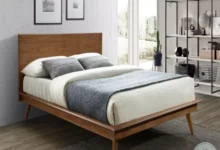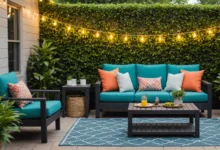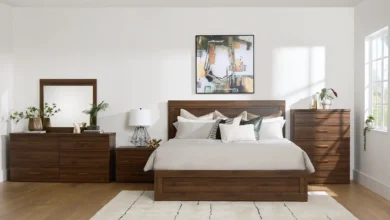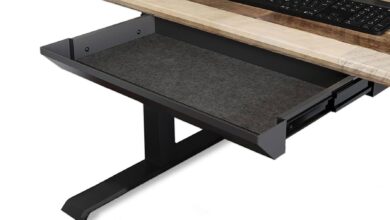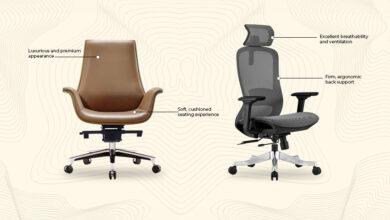Unveiling the Ultimate Recliner Collection: Top Picks for Comfort and Style
Finding the perfect recliner can transform your living room from a functional space into a haven of relaxation. Whether you’re seeking ultimate comfort for movie nights, a soothing escape after a long day, or just a place to unwind with a good book, the right recliner can make all the difference. This guide explores some of the best options available, considering factors like comfort, style, and budget, to help you choose the perfect chair for your needs.
Contents
- 1 Factors to Consider When Choosing the Perfect Recliner
- 2 Comfort: The Ultimate Recliner Test
- 3 Recliner Materials: A Look at Durability and Aesthetics
- 4 Recliner Mechanisms: Smooth Operation and Versatility
- 5 Size and Style: Matching Your Space and Personality
- 6 Price and Value: Balancing Quality and Budget
- 7 Ease of Maintenance: Keeping Your Recliner Pristine
- 8 Warranty and Guarantee: Protecting Your Investment
- 9 Customer Reviews: Learning from Others’ Experiences
- 10 Ergonomics: Promoting Healthy Sitting
- 11 Factors to Consider When Choosing Your Perfect Recliner
- 12 The Importance of Comfort: Beyond Just Soft Cushions
- 13 Recliner Size and Space Considerations
- 14 The Durability of the Frame and Materials
- 15 Recliner Mechanisms and Ease of Use
- 16 Budgeting and Price Point Considerations
- 17 Additional Features: Beyond the Basics
- 18 Warranty and After-Sales Service
- 19 Style and Aesthetics
- 20 Reviews and Customer Feedback
- 21 Choosing the Right Recliner for Your Needs
- 22 Recliner Types: Finding Your Ideal Position
- 23 Materials and Construction: Durability and Longevity
- 24 Comfort and Support: Finding Your Perfect Fit
- 25 Price and Value: Balancing Your Budget
- 26 So, Which Recliner Is Right For You?
Factors to Consider When Choosing the Perfect Recliner
Before diving headfirst into the world of plush recliners, it’s crucial to understand what makes a good one. It’s not just about looks; comfort, practicality, and your budget all play a significant role. Think about your lifestyle and needs. Are you a light reader who enjoys a quiet evening? Or a movie marathon enthusiast who needs maximum comfort and recline? A recliner that’s perfect for one person might not be ideal for another. Consider the size and layout of your living space. A bulky recliner might overwhelm a small room, while a compact one might feel cramped in a spacious area. Don’t forget about the materials used. High-quality fabrics and durable construction will significantly impact the recliner’s lifespan. Choosing the right recliner is about finding the perfect balance between aesthetics, comfort, and long-term value.
Comfort: The Ultimate Recliner Test
Comfort is king when it comes to recliners. It’s not just about the plushness of the cushions; it’s about the entire seating experience. Think about how you like to sit. Do you prefer a firm seat or something a bit more yielding? Do you need lumbar support to keep your spine aligned? Consider the materials used. Some fabrics breathe better than others, which can affect comfort levels, especially if you tend to get warm while relaxing. A good recliner should cradle you in a supportive, yet comfortable embrace. Imagine sinking into a recliner and feeling the weight lift from your body. That’s the kind of comfort you should be looking for. And of course, the reclining mechanism plays a crucial role. A smooth and easy-to-use mechanism can be the difference between a delightful experience and a frustrating one. Test out the recline, the adjustability, and the general ease of use. Look for reclining mechanisms that offer multiple positions, allowing you to find the perfect setting for reading, watching TV, or simply unwinding. Ultimately, the ideal recliner will be tailored to your specific preferences and body type.
Recliner Materials: A Look at Durability and Aesthetics
Recliner materials significantly impact the overall experience and lifespan of your furniture. Fabric is a major player. High-quality upholstery materials are typically more durable, stain-resistant, and easier to maintain. Consider factors like the weight and texture of the fabric. Some fabrics, such as leather or microfiber, might feel more luxurious, while others, like linen or cotton blends, offer a softer touch. Leather, for instance, is known for its durability and classic aesthetic, but it can be more expensive and might require more care and maintenance. Microfiber is another popular choice because of its easy-care properties. Consider the overall aesthetics you’re seeking. Do you prefer a classic, sophisticated look, or something more modern and contemporary? The material should complement your existing décor and personal style. When testing out materials, sit on the recliner for a few minutes. How does the fabric feel against your skin? Does it feel too hot or too cold? Consider the color palette. A darker color might show stains more easily, while a lighter color might be more susceptible to fading. Think about the environment your recliner will be in. Heavy use might necessitate a more durable material. All these factors contribute to the long-term value and enjoyment of your reclining chair.
Recliner Mechanisms: Smooth Operation and Versatility
The recliner mechanism is the heart and soul of the chair. It’s the part that allows you to recline and adjust to your perfect position. A smooth and responsive mechanism is essential for a comfortable and satisfying experience. Look for mechanisms with a sturdy build and a quiet operation. A creaky or jerky mechanism will quickly become frustrating, ruining your relaxation time. Consider the reclining range. Does the mechanism allow you to recline to a fully horizontal position, or just to a slight angle? This will impact the chair’s suitability for different activities, such as napping or watching movies. Adjustable headrests are a must-have feature for some. They allow you to fine-tune your comfort depending on the task or your body type. Furthermore, consider the mechanism’s longevity. A well-built mechanism will stand the test of time and withstand frequent use without breaking down. Look for mechanisms backed by warranties, which indicate a manufacturer’s confidence in their product’s quality. It’s an important aspect to consider.
Size and Style: Matching Your Space and Personality
The size and style of your recliner should complement your living space and personal style. A large, bulky recliner might overwhelm a small living room, making the area feel cramped. Conversely, a compact recliner in a spacious room could look lost or insignificant. Consider the overall dimensions, including seat depth, width, and height. Measure your space to ensure the recliner will fit comfortably and doesn’t intrude on the flow of your room. Think about the aesthetics of your current décor and the style you want to achieve. A sleek, modern recliner might not complement a traditional living room, while a rustic, arm-chair style recliner could feel out of place in a modern setting. Match the style with the overall décor. The right recliner will blend in seamlessly, enriching your space while enhancing the desired ambiance. Ultimately, the recliner should be functional, stylish, and appropriate for your space.
Price and Value: Balancing Quality and Budget
Price is a significant factor when purchasing a recliner. Understand that there’s a wide range of prices, from budget-friendly options to high-end luxury recliners. Set a realistic budget before starting your search to avoid overspending. Consider the features, materials, and build quality offered in each recliner. A recliner priced significantly lower than others might lack the durability and comfort you need. Assess the long-term value of the recliner. A high-quality recliner with durable construction and materials will likely provide years of enjoyment, offsetting the higher initial cost. On the other hand, a cheaper recliner may need replacement sooner, resulting in extra expenses down the road. Balance your budget and needs when making a purchase decision. Factor in potential maintenance costs as well, which can vary greatly between different materials. Look at warranties, reviews, and comparable products to assess the value for your money.
Ease of Maintenance: Keeping Your Recliner Pristine
Maintaining your recliner should be a simple and straightforward process. Choosing a recliner with easy-to-clean materials is a worthwhile consideration. Some fabrics, like leather or microfiber, are inherently easier to maintain than others. Look for materials that are resistant to stains and spills. Regular cleaning and proper care can help prolong the life of your recliner. Also, understand that your specific needs will vary depending on your lifestyle. Someone who has children or pets may require a more resistant recliner than someone who is a minimalist. Proper cleaning methods will help in preserving the aesthetic quality of the recliner and avoid damage in the long run. Knowing the care instructions before purchase is important to avoid future maintenance issues.
Warranty and Guarantee: Protecting Your Investment
Recliners, like any significant purchase, should come with some form of warranty. This protects your investment by ensuring the manufacturer stands behind their product. A comprehensive warranty can offer peace of mind, allowing you to confidently rely on the product’s quality and durability. Read the warranty carefully to understand the coverage period, the specific defects covered, and the terms and conditions. A robust warranty can offer significant protection against defects and potential issues in the long run. This is a significant factor to consider when evaluating different models.
Customer Reviews: Learning from Others’ Experiences
Customer reviews can be invaluable when deciding on a recliner. These real-world accounts from previous buyers offer insights into the chair’s comfort, durability, and functionality. Look for recurring themes in the reviews. Are customers praising the smooth recline mechanism or the plush seating? Or are there complaints about durability or assembly issues? Pay attention to the overall tone and sentiment expressed in the reviews. Negative feedback can provide valuable insight into potential problems with the recliner. By considering customer reviews, you can gain a more holistic understanding of the recliner’s practical aspects.
Ergonomics: Promoting Healthy Sitting
Ergonomics is an essential factor when choosing a recliner. A well-designed recliner will support your posture, reducing strain on your body and promoting healthy sitting habits. Consider factors like lumbar support, which can keep your spine aligned and prevent back pain during extended sitting sessions. Adjustable headrests can also contribute to better posture and support during relaxation. A recliner that takes into account ergonomics will create a comfortable and healthy experience, minimizing discomfort and promoting well-being. Proper ergonomic design should be a priority when searching for your new recliner.
Factors to Consider When Choosing Your Perfect Recliner
Choosing the right recliner isn’t just about finding something comfortable; it’s about finding a piece of furniture that seamlessly integrates into your lifestyle and enhances your relaxation. There are a multitude of factors to consider, and understanding these nuances will help you avoid costly mistakes and ensure you’re investing in a recliner that truly serves your needs. Think of it as a deep dive into your relaxation preferences. You wouldn’t buy a car without knowing its features and fuel efficiency, right? Similarly, researching the specifics of a recliner is crucial for long-term satisfaction. Don’t rush this process; it’s about getting the recliner that’s perfect for you.
The Importance of Comfort: Beyond Just Soft Cushions
Comfort isn’t just about soft cushions; it’s about the overall ergonomic design of the recliner. Consider the lumbar support. Does it provide adequate arch support to relieve back pain and pressure points? A properly designed recliner should cradle your body in a way that encourages relaxation, not discomfort. Think about the type of fabric, too. Is it breathable? Does it feel plush and inviting? A silky microfiber might feel luxurious, but if it doesn’t allow for airflow, it could become uncomfortably warm, especially on hot days. Consider the density of the foam and the overall design of the seat. Are the arms supportive and well-contoured? A poorly designed armrest can throw off the whole posture. Remember to consider the recliner’s recline mechanisms. Does it provide a smooth, steady recline, or does it feel jerky or unstable? This smoothness and firmness will be crucial for consistent relaxation. Testing the recliner’s recline position in different angles is highly recommended to find the best fit for your body type and preferences.
Recliner Size and Space Considerations
Recliners come in a range of sizes, and selecting the right size is essential for your living space. If you have a large living room, a wider, more expansive recliner could be perfect. If your space is more compact, a smaller recliner might be more practical and aesthetically pleasing. Think about the room’s layout and how the recliner will fit within it. Will it impede traffic flow? Will it be in a corner or against a wall? Consider also how the recliner will appear in the room. A bulky recliner in a small room might overwhelm the space. Conversely, a tiny recliner might feel lost and out of place in a large room. Don’t underestimate the importance of visual balance. Measuring the available space is crucial before making a purchase. Ensure the recliner will fit comfortably without feeling cramped or overly prominent in the room. Consider the placement of other furniture and how the recliner will interact with that existing décor.
The Durability of the Frame and Materials
The frame is the backbone of your recliner, and the longevity of your purchase depends heavily on its quality. Look for durable materials like steel or solid wood. A poorly constructed frame will sag, break, or crack over time, diminishing the comfort and potentially even posing safety concerns. Research the frame’s construction to understand its support mechanisms and how the weight of the user is distributed. Does the recliner’s design seem to be well-built, or do you perceive potential weaknesses? Examine the construction quality of the components. Pay close attention to the joints, welds, and screws. A sturdy frame is essential for years of consistent use, especially for heavier users or families.
Recliner Mechanisms and Ease of Use
The mechanism that allows your recliner to recline is critical. Some use gas lifts, while others employ hydraulic or spring-loaded systems. Consider how easily the recline mechanism functions. Is it smooth, or does it feel stiff or jerky? This could indicate issues with wear and tear over time. Furthermore, consider the stability of the recliner in the fully reclined position. Does it feel secure and stable, or does it wobble? Check the reclining mechanisms extensively to get a feel for their responsiveness and longevity. A well-designed recliner will function seamlessly, making relaxation effortless.
Budgeting and Price Point Considerations
The price of a recliner can vary significantly depending on the materials, features, and brand. Establish a realistic budget before you start shopping. While a super-cheap option might seem attractive, it could compromise long-term comfort and durability. Evaluate the value proposition of each recliner you consider. Consider whether the additional cost of a higher-quality recliner is worth the investment in terms of longevity and comfort. Be prepared to compare features and functionalities with different price ranges. There’s a good chance you can find an excellent recliner without breaking the bank.
Additional Features: Beyond the Basics
Recliners often come with extra features like adjustable headrests, footrests, and cup holders. These additions can greatly enhance your relaxation experience. Consider your specific needs and how these extra features will improve your comfort and convenience. If you have guests often, a recliner with extra storage space for blankets or pillows might be beneficial. Are you a reader? A built-in reading light can be a delightful addition. Evaluate how these features will add to the overall usability and satisfaction of owning a recliner.
Warranty and After-Sales Service
Don’t overlook the importance of a warranty and after-sales service. A strong warranty demonstrates the manufacturer’s confidence in the product’s quality. Consider the terms and conditions of the warranty to ensure it covers potential manufacturing defects or mechanical issues. Check for reputable after-sales service. A company that actively handles customer support and repairs effectively will ease your mind in the long run. Knowing you have assistance and support can be an invaluable factor.
Style and Aesthetics
Recliners should not just serve a function; they should also complement your room’s décor. Consider the style of your home and the existing furniture. Does the recliner blend in or create a distinct visual statement? Think about the color, texture, and overall design aesthetic. Selecting a recliner that matches your home’s overall style will create a harmonious and inviting space for relaxing.
Reviews and Customer Feedback
Finally, take advantage of online reviews and customer feedback. Reading other people’s experiences with different recliners can provide valuable insights and help you make an informed decision. Look for patterns in the reviews to identify common issues or praise points. Pay particular attention to the long-term experiences shared by users; this can offer the clearest picture of a recliner’s overall performance. Don’t just rely on flashy marketing; seek out genuine, honest feedback.
Choosing the Right Recliner for Your Needs
Picking the perfect recliner is a personal journey, and there’s no one-size-fits-all solution. Your individual needs and preferences should be your guiding stars. Consider your budget, the size of your living space, and most importantly, the comfort you crave. Are you looking for a simple, everyday relaxation option, or a luxurious, full-body massage experience? Do you have any existing health issues that might influence your posture and comfort while reclining? Honest self-assessment is key to discovering the ideal recliner for your life. For example, someone with back pain might prioritize adjustable lumbar support, whereas a frequent movie watcher might prioritize a wide seat and plush cushions. Don’t be afraid to prioritize features that enhance your overall well-being, from simple armrests to innovative mechanisms that adjust your reclining position. Read online reviews, ask friends for recommendations, and look for any special deals or discounts before making your final purchase. Understanding your specific needs and lifestyle will help you navigate the vast world of recliners and make a decision that truly caters to your comfort.
Recliner Types: Finding Your Ideal Position
There are various types of recliners, each with its own unique mechanisms and features. Knowing the difference between a simple rocker recliner and an electric power recliner can significantly influence your choice. A standard recliner typically uses a lever or a simple mechanism to recline. This can be a great, budget-friendly option for basic relaxation. Electric recliners, on the other hand, offer a more sophisticated approach, allowing for fully adjustable positions with the push of a button or remote. They are often preferred for convenience and added support. Some recliners even incorporate zero-gravity mechanisms for optimal relaxation and spinal support, offering the feeling of weightlessness. Another consideration is the type of fabric and upholstery. Look for high-quality materials that are durable, easy to clean, and reflect your personal aesthetic. Factors like the depth of the seat, armrest design, and leg support all contribute to comfort. Consider what activities you intend to do in the recliner and how it may support those needs. Maybe you need additional support for your feet or a deeper recline for better movie-watching? Think about how these features might enhance your life and overall well-being.
Materials and Construction: Durability and Longevity
The construction and materials of a recliner significantly impact its longevity and your overall enjoyment. Choosing sturdy materials like high-quality wood frames, strong springs, and resilient upholstery is crucial. A poorly constructed recliner can break down quickly, leading to frustration and expense. Compare the features offered by different brands and models. Consider what your usage will be like – if you’ll be using it daily, a higher-quality build is essential. A solid frame will ensure the recliner maintains its shape and stability over time. Look for reinforced joints, strong stitching, and well-cushioned seats and backs. Avoid cheap materials that may not hold up under regular use. Consider the density of the foam padding – denser foam offers greater comfort and support. Look for water-resistant or stain-resistant upholstery options if you have pets or children.
Comfort and Support: Finding Your Perfect Fit
Comfort is paramount when choosing a recliner. Consider the depth of the seating, the height of the back, and the armrest design. A good recliner will support your body naturally. Think about your posture and the way you typically relax. Some people prefer a deeper seat, while others might need more lumbar support. The key here is finding a balance between comfort and support.
| Recliner Feature | Importance |
|---|---|
| Seat Depth | Influences posture and overall comfort |
| Back Height and Angle | Critical for spinal support and relaxation |
| Armrest Design | Affects ergonomics and comfort during relaxation |
| Padding Density | Directly impacts comfort and support |
A poorly-designed recliner can cause pressure points and discomfort over time. Pay close attention to the materials used for padding – high-quality foam and springs contribute to long-term comfort. Consider any existing health conditions you may have. If you have back pain, for instance, look for recliners that provide lumbar support. Also, take the time to sit and recline in the recliner before you buy it. Feel the support and see if the design is ideal for you. A good recliner should provide ergonomic support for your body while you relax.
Price and Value: Balancing Your Budget
Price is often a significant factor when choosing a recliner. While some luxury recliners have a high price tag, you can find excellent value at varying price points. It’s important to carefully consider your budget and the features you prioritize. A lower-cost recliner might compromise on some aspects like build quality or materials, but it could still meet your basic needs. Research different brands and models to understand the price ranges associated with various features and qualities. Don’t be tempted to sacrifice quality for a lower price, as this could impact the lifespan of the recliner significantly. Compare the features and functionalities of different models before committing to a purchase. Sometimes a higher initial cost can translate into substantial long-term savings due to the durability and longevity of the product. Look for sales and discounts as well!
So, Which Recliner Is Right For You?
Well, there you have it – a comprehensive look at some of the best recliners on the market. Hopefully, this guide has helped you narrow down your choices and find the perfect fit for your needs and your space. Now go forth and relax in style! Thanks for reading, and be sure to check back later for more home improvement and lifestyle tips. We’ll be updating our guides regularly, so you won’t miss out on the latest and greatest in comfy furniture.

